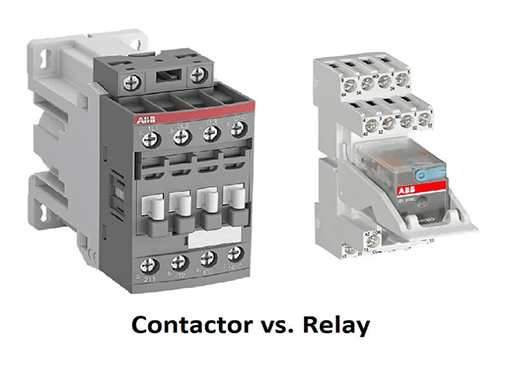
Figure 1: Contactor vs. Relay.
The contactor and the relay are all control devices used in electric circuit. But they cannot replace each other. The followings are the main differences between the two.
1. Definitions
The contactor is divided into alternating current (AC) and direct current (DC), often used in distribution and electricity applications, and is an electrical appliance that controls loads.
The relay is an automatic electrical appliance, mainly used for distance making and breaking capacity control circuits, and for control and signal conversion in electric drive. The relay is represented by the single letter K; the contactor is represented by KM.
2. Functions
The contactor is used to make or break, and the large-capacity contactor has an arc extinguishing cover, which will not exceed 5A.
In contrast, the contacts of small relays only need about 1A or 2A. Its contacts are not divided into main and auxiliary contacts, and the contacts are normally open and normally close contacts.
The function of the relay is signal detection, transmission, conversion, etc. Its on-off circuit current is relatively small, and it is mainly used in control circuits and weak signals. It can be combined into a time relay, counter, etc., with additional functions, but the contactor does not.
3. Contact Open and Close
The contactor is mainly used to connect or disconnect loads with relatively large power, and is often used in main circuits. It can have interlocking contacts to indicate the open and close of the main contacts.
The relay is often used in electrical control circuits to expand the contact capacity of miniature or small relays to drive larger loads. Relay contacts are mainly used to turn on or off the coil of the contactor, which requires more open and close contacts than the contactor does.

Figure 2: A Single Pole Double Throw (SPDT) relay.
4. Arc Extinguishing
The contactor has an arc extinguishing device, because the contactor has a large current, and arc will be generated when it is in contact.
The relay does not have an arc extinguishing device, because the contact current of the relay is small, and no arc will be generated when it is touched. If the relay is used to turn on and off the DC circuit, generally two normally open contacts are connected in series, and the arc can be quickly extinguished without arcing.
Related Info
Top 3 Things you must Know about Circuit BreakerWhat is a Magnetic Contactor?
Advantages of a Permanent Magnet Contactor
The Working Principle of the Vacuum Contactor
How to Calculate the Breaking Capacity?


